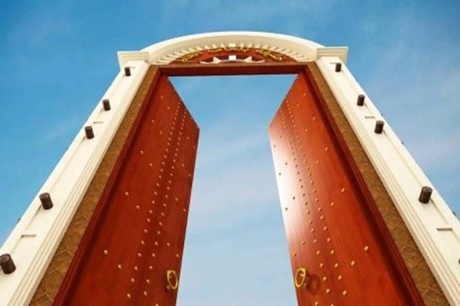The oldest wood door in the world was discovering in Switzerland while digging underneath an Opera house. Built around the same time as Stonehenge, the 5000 year old door has “a clever design that even looks good.”(http://www.bbc.com/news/world-europe-11593005)
The world’s largest wood door is in the United Arab Emirates and is dedicated to the country’s president Sheikh Khalifa. The door is made of teak and stands more than eighty feet tall. (http://www.thenational.ae/news/uae-news/inspiration-behind-the-forthcoming-worlds-biggest-gate-in-uae)

Cavemen got tired of predators wandering into their caves and causing trouble so they decided to create a barrier that would be easy for humans to get through but hard for animals without opposable digits. While stone and metal were often used in monumental doors such as in Temples and government buildings, wood was the common man’s material. The exception was King Solomon’s temple, whose door was made of olive wood. Asian doors from antiquity often included rice paper framed by bamboo.
Moving up to the High Middle Ages, the designs become unique to a historical period and region. For example English doors from the Tudor period (1485-1625) are very different from English doors during the Baroque period (1625-1715). Discussing the obvious inferiority of wood doors during the British Victorian period (1837-1901) to those of the American Victorian period (1840-1910) seems like a good way to get into a fist fight with a woodcarver. These detailed changes are meticulously cataloged by the woodcarver’s guild of London (est. 1208 AD).
We can touch upon a few of these design periods as some of the styles are still popular today.
Colonial Doors 1607-1780
As the name implies, these doors are of a style adopted by the European colonies. They were generally constructed with wood slates and little decoration. As the colonies became more cosmopolitan, the main entry doors were often carved in patterns akin to their European counterparts.
Beaux arts/Art Deco
Any respectable art history student would be very upset with the above pairing but the two styles are very complicated and inspired by the respected art movements of the times.
Contemporary/Modern
The greatest advancement in wood door technology is the ability to make doors that don’t warp with heat and humidity. Making doors out of wood composite with a nice solid wood veneer mitigates the negative atmospheric effects.


